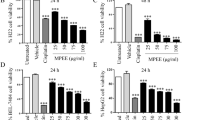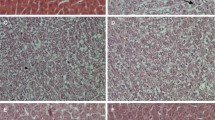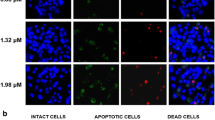Abstract
Hepatocellular carcinoma (HCC) is one of the most common cancers, which may lead to death. Menadione shows cytotoxic activity thought affecting redox cycling in cancer cells. The aim of the present study was to investigate the effects of menadione on rat hepatocellular carcinoma (H4IIE) cell morphology, cytotoxicity, apoptosis and DNA damage or repair in vitro. Cell morphology evaluated by microscopy and cell viability was determined using the 3-[4,5-dimethylthiazol-2yl]-diphenyltetrazolium bromide test. Apoptotic cell death was assessed in H4IIE cells treated with menadione by 4′,6-diamidino-2-phenylindole staining. Quantitative real time polymerase chain reaction used to determine the expression level of poly (ADP-ribose) polymerase 1 (PARP1) gene. According to the results of this study menadione has got a cytotoxic activity (IC50 25 µM) and change the cell fate in H4IIE cells. Menadione treatments lead to PARP1 activation in a dose dependent manner and induce DNA damage and apoptosis, and this may suggest its use as a therapeutic agent in HCC treatment.





Similar content being viewed by others
References
Abe K, Saito H (1996) Menadione toxicity in cultured rat cortical astrocytes. Jpn J Pharmacol 72:299–306
Acharya PR, Choudhury D, Das A, Chakrabarti G (2009) Vitamin K3 disrupts the microtubule networks by binding to tubulin: a novel mechanism of its antiproliferative activity. Biochemistry 48:6963–6974
Akiyoshi T, Matzno S, Sakai M, Okamura N, Matsuyama K (2009) The potential of vitamin K3 as an anticancer agent against breast cancer that acts via the mitochondria-related apoptotic pathway. Cancer Chemother Pharmacol 65:143–150
Altmayer M, Hottiger MO (2009) Poly (ADP ribose) polymerase 1 at the crossroad of metabolic stress and inflammation in aging. Aging 1:458–460
Barton VN, Donson AM, Kleinschmidt-DeMasters BK, Gore L, Liu AK, Foreman NK (2009) PARP1 expression in pediatric central nervous system tumors. Pediatr Blood Cancer 53:1227–1230
Cao H, Feng Q, Xu W, Li X, Kang Z, Ren Y, Du L (2010) Genipin induced apoptosis associated with activation of the c-Jun NH2-terminal kinase and p53 protein in HeLa cells. Biol Pharm Bull 33:1343–1348
Choi KC, Chung WT, Kwon JK, Yu JY, Jang YS, Park SM, Lee SY, Lee JC (2010) Inhibitory effects of quercetin on aflatoxin B1-induced hepatic damage in mice. Food Chem Toxicol 48:2747–2753
Conde de la Rosa L, Schoemaker MH, Vrenken TE, Buist-Homan M, Havinga R, Jansen PL, Moshage H (2006) Superoxide anions and hydrogen peroxide induce hepatocyte death by different mechanisms: involvement of JNK and ERK MAP kinases. J Hepatol 44:918–929
El-Serag HB, Rudolph KL (2007) Hepatocellular carcinoma: epidemiology and molecular carcinogenesis. Gastroenterology 132:2557–2576
Gonçalves A, Finetti P, Sabatier R, Gilabert M, Adelaide J, Borg JP, Chaffanet M, Viens P, Birnbaum D, Bertucci F (2011) Poly(ADP-ribose) polymerase-1 mRNA expression in human breast cancer: a meta-analysis. Breast Cancer Res Treat 127:273–281
Hong SJ, Dawson TM, Dawson VL (2004) Nuclear and mitochondrial conversations in cell death: PARP-1 and AIF signaling. Trends Pharmacol Sci 25:259–264
Ji Y, Tulin AV (2010) The roles of PARP1 in gene control and cell differentiation. Curr Opin Genetics Dev 20:512–518
Kapoor NR, Kumar V (2012) Hepatitis B virus: a molecular perspective. Proc Natl Acad Sci Sect B Biol Sci 82:31–41
Lamson DW, Plaza SM (2003) The anticancer effects of vitamin K. Altern Med Rev 8:303–318
Leung SW, Huang EY, Cheng YF, Lu SN (2000) Conformal radiation therapy for hepatoma with portal vein thrombosis. Br J Radiol 73:550–552
Li HN, Nie FF, Liu W, Dai QS, Lu N, Qi Q, Li ZY, You QD, Guo QL (2009) Apoptosis induction of oroxylin A in human cervical cancer HeLa cell line in vitro and in vivo. Toxicology 257:80–85
Liang Y, Yin D, Hou L, Zheng T, Wang J, Meng X, Lu Z, Song X, Pan S, Jiang H, Liu L (2011) Diphenyl difluoroketone: a potent chemotherapy candidate for human hepatocellular carcinoma. PLoS ONE 6:e23908
Livak KJ, Schmittgen TD (2001) Analysis of relative gene expression data using real-time quantitative PCR and the 2−ΔΔCTmethod. Methods 25:402–408
Loor G, Kondapalli J, Schriewer JM, Chandel NS, VandenHoek TL, Schumacker PT (2010) Menadione triggers cell death through ROS-dependent mechanisms involving PARP activation without requiring apoptosis. Free Radic Biol Med 49:1925–1936
Matzno S, Yamaguchi Y, Akiyoski T, Nakayashi T, Matsuyama K (2008) An attempt to evaluate the effect of vitamin K3 using as an enhancer of anticancer agents. Biol Pharm Bull 31:1270–1273
Mosmann T (1983) Rapid colorimetric assay for cellular growth and survival: application to proliferation and cytotoxicity assay. J Immunol Methods 65:55–63
Motola-Kuba D, Zamora-Valdés Uribe M, Méndez-Sánchez N (2006) Hepatocellular carcinoma. An overview. Ann Hepatol 5:16–24
Ngo EO, Sun TP, Chang JY, Wang CC, Chi KW, Cheng AL, Nutter LM (1999) Menadione-induced DNA damage in a human tumor cell line. Biochem Pharma 42:1961–1968
Nishikawa Y, Carr BI, Wang M, Kar S, Finn F, Dowd P, Zheng ZB, Kerns J, Naganathan S (1995) Growth inhibition of hepatoma cells induced by vitamin K and its analogs. J Biol Chem 270:28304–28310
Nutter LM, Cheng AL, Hung HL, Hsieh RK, Ngo EO, Liu TW (1991) Menadione: spectrum of anticancer activity and effects on nucleotide metabolism in human neoplastic cell lines. Biochem Pharmacol 41:1283–1292
Ogawa M, Nakai S, Deguchi A, Nonomura T, Masaki T, Uchida N, Yoshiji H, Kuriyama S (2007) Vitamins K2, K3 and K5 exert antitumor effects on established colorectal cancer in mice by inducing apoptotic death of tumor cells. Int J Oncol 31:323–331
Osada S, Sakashita F, Hosono Y, Nonaka K, Tokuyama Y, Tanaka H, Sasaki Y, Tomita H, Komori S, Matsui S, Takahashi T (2008) Extracellular signal-regulated kinase phosphorylation due to menadione-induced arylation mediates growth inhibition of pancreas cancer cells. Cancer Chemother Pharmacol 62:315–320
Parikh S, Hyman D (2007) Hepatocellular cancer: a guide for the internist. Am J Med 120:194–202
Park WH, Han YH, Kim SH, Kim SZ (2007) Pyrogallol, ROS generator inhibits As4.1 juxtaglomerular cells via cell cycle arrest of G2 phase and apoptosis. Toxicology 235:130–139
Sasaki R, Suzuki Y, Yonezawa Y, Ota Y, Okamoto Y, Demizu Y, Huang P, Yoshida H, Sugimura K, Mizushina Y (2008) DNA polymerase γ inhibition by vitamin K3 induces mitochondria-mediated cytotoxicity in human cancer cells. Cancer Sci 99:1040–1048
Takahashi K, Shibata T, Oba T, Ishikawa T, Yoshikawa M, Tatsunami R, Takahashi K, Tampo Y (2009) Multidrug-resistance-associated protein plays a protective role in menadione-induced oxidative stress in endothelial cells. Life Sci 84:211–217
Warren MC, Bump EA, Medeiros D, Braunhut SJ (2000) Oxidative stress-induced apoptosis of endothelial cells. Free Radic Biol Med 29:537–547
Wong CM, Ng IOL (2008) Molecular pathogenesis of hepatocellular carcinoma. Liver Int 28:160–174
Wu J, Chien CC, Yang LY, Huang GC, Cheng MC, Lin CT, Shen SC, Chen YC (2011) Vitamin K3-2,3-epoxide induction of apoptosis with activation of ROS-dependent ERK and JNK protein phosphorylation in human glioma cells. Chem Biol Interact 193:3–11
Xu YZ, Zheng RL, Zhou Y, Peng F, Lin HJ, Bu Q (2011) Small molecular anticancer agent SKLB703 induces apoptosis in human hepatocellular carcinoma cells via the mitochondrial apoptotic pathway in vitro and inhibits tumor growth in vivo. Cancer Lett 313:44–53
Yang TS, Wang CH, Hsieh RK, Chen JS, Fung MC (2002) Gemcitabine and doxorubicin for the treatment of patients with advanced hepatocellular carcinoma: a phase I-II trial. Ann Oncol 13:1771–1778
Zhang C, Baffi J, Cousins SW, Csaky KG (2003) Oxidant-induced cell death in retinal pigment epithelium cells mediated through the release of apoptosis-inducing factor. J Cell Sci 116:1915–1923
Author information
Authors and Affiliations
Corresponding author
Rights and permissions
About this article
Cite this article
Oztopcu-Vatan, P., Sayitoglu, M., Gunindi, M. et al. Cytotoxic and apoptotic effects of menadione on rat hepatocellular carcinoma cells. Cytotechnology 67, 1003–1009 (2015). https://doi.org/10.1007/s10616-014-9739-7
Received:
Accepted:
Published:
Issue Date:
DOI: https://doi.org/10.1007/s10616-014-9739-7




